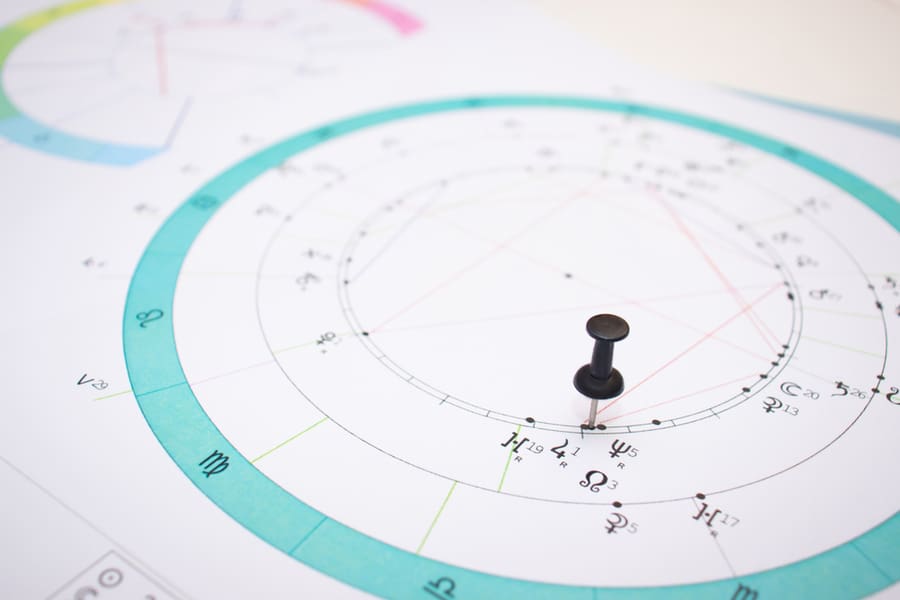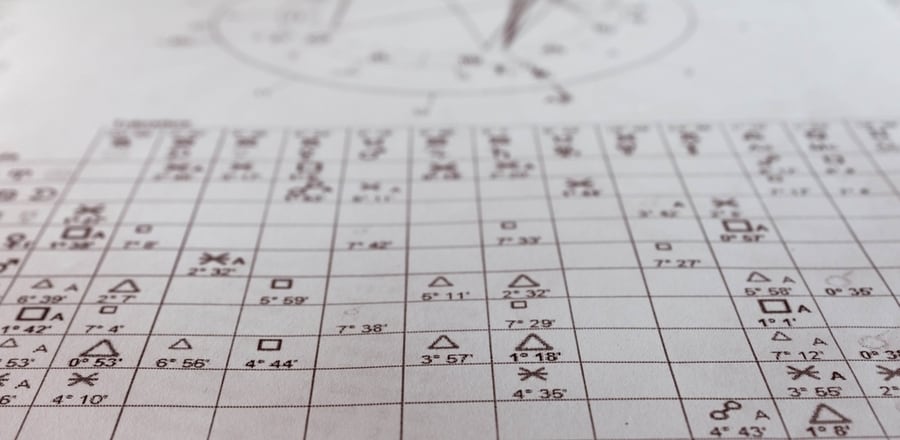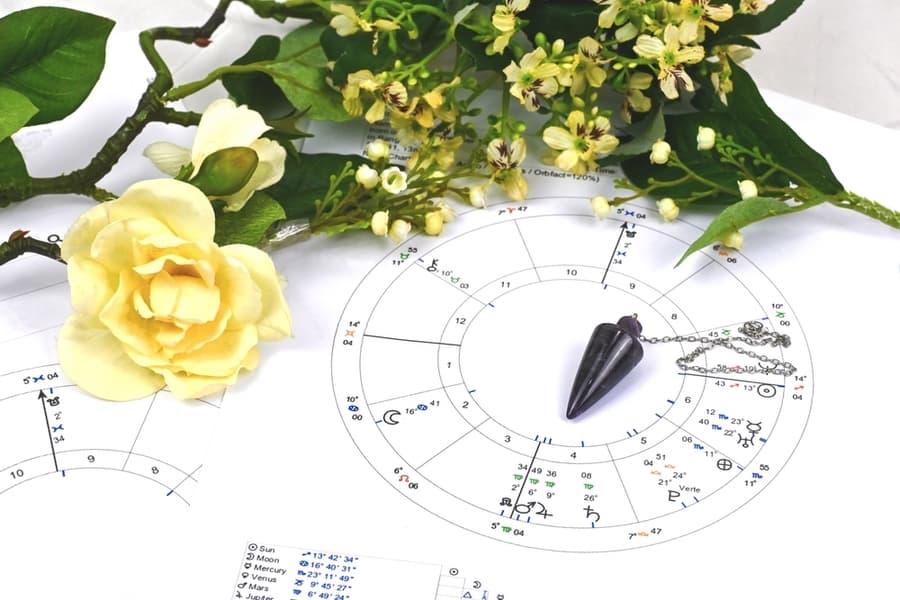
Astrology is a great way to gain insight into your life and relationships. But with so many aspects and angles to consider, the discipline can be overwhelming.
Are you fascinated by the complex web of energies that make up our natal charts? Have you ever wondered about planetary aspects’ impact on our personalities and life experiences? The answer lies behind knowing how to read aspects in astrology.
At first, you need to understand the meaning of each aspect. Then, you should examine the position of the planets involved in each aspect within the zodiac and their distance from each other. Finally, you can interpret the impact of each aspect on an individual’s personality traits, relationships, and life experiences.
In this article, you’ll discover how to read the different aspects of astrology with our comprehensive guide. Learn how to interpret planetary alignments and their impact on your life.
What Exactly Are Aspects in Astrology?

Think of your chart as a 360-degree map of the stars during your moment of birth. Planets move at different speeds and can be found in different parts of every natal chart. Astrology has a few different aspects, but we’ll start with the major ones: conjunction, opposition, square, trine, and sextile.
An aspect is basically two planets that create an angle with one another in the sky. When two planets are in aspect, it means that they are interacting with each other energetically. The type of aspect depends on the angle formed, which determines the nature of that interaction.
Don’t Forget the Orbs

In astrology, there are what we call orbs.
These refer to the allowable margin of error or deviation that astrologers use when considering the positions of planets and other celestial bodies in a birth chart or horoscope.
The size of the orb used by an astrologer may vary depending on their individual interpretation and the specific planetary configuration being analyzed.
Orbs in conjunction refer to the degree range within which two planets must be located in order to be considered conjunct. This is because they are in close proximity to one another.
For example, a tight orb of only a few degrees might be used when considering the conjunction of the Sun and Moon, while a wider orb of several degrees might be used when analyzing the conjunction of two outer planets, such as Uranus and Neptune.
In general, the tighter the orb used in conjunction analysis, the more powerful and pronounced the influence of the planetary alignment is believed to be.
In special cases, some astrologers may choose to use wider orbs in order to capture a broader range of energies and influences in a birth chart.
The 5 Major Aspects in Astrology

The aspects in an astrological chart are like a celestial conversation and relationships between planets, revealing the intricate system of energies that inevitably affect each one of us.
These planetary connections provide a framework for understanding our personalities, relationships, and life experiences, offering valuable insights into the mysteries of the universe and our place within it.
Conjunction
A conjunction is an aspect that occurs when two or more planets are positioned close together in the same sign or house of the zodiac.
The conjunction is considered one of the most powerful and significant aspects of astrology, as it combines the energies and influences of two planets, amplifying their effects on each other.
These two planets may likewise be interdependent. Due to how close their energies are, the influence of each (planet) may be difficult to tell apart.
The nature of a conjunction can vary depending on the planets involved and the sign and house in which it occurs. In general, a conjunction can indicate a strong merging of the energies represented by the planets involved.
For example, a conjunction between Venus and Mars in a synastry chart can suggest a strong sexual attraction or romantic connection between two people. A conjunction between Mercury and Uranus in the same chart can likewise mean a powerful intellectual connection or a combined talent for innovation and invention.
Nevertheless, a conjunction can also indicate a potential for overemphasis or conflict between the energies represented by the planets involved. For instance, a conjunction between Saturn and Pluto can indicate a potential for intense power struggles or challenges in the areas of control and authority.
Opposition
Oppositions in a chart can be complex, representing a dynamic tension between two planets that are 180° apart in the zodiac.
This aspect occurs when two planets are in opposite signs, creating a direct line of energy between them. For instance, if your Sun is in Gemini and your Pluto is in Sagittarius within the allowable orb, they are said to be in an oppositional aspect.
Oppositions represent a struggle between two opposing forces that must be reconciled, integrated, or balanced. They can bring about a sense of polarity, conflict, or duality in our lives as we try to navigate and balance the energies of the two planets involved.
The opposition can be a challenging aspect, as it can represent a clash between different parts of ourselves or different people in our lives. Unlike the square, the signs in the opposition aspect generally get along and only seek stability between themselves.
On the bright side, oppositions can also be a source of growth and learning. When we are able to integrate and balance the energies of the two planets involved, we can achieve a sense of wholeness and harmony.
Square
The square is one of the most challenging and dynamic aspects that can bring about a lot of tension. The signs involved form a square in a chart and traditionally don’t get along, therefore causing friction.
When two planets are 90° apart, they form a square aspect that creates a sense of conflict, resistance, and obstacles. The energy between these planets can feel like two forces pushing against each other, creating a sense of tension and stress.
For example, when your Sun is in Capricorn, and your Moon is in Aries, they are said to be square one another.
As challenging as it can be, the square aspect also presents opportunities for growth and transformation.
The unique challenges that this aspect brings push us to confront our limitations, fears, and weaknesses and to find creative solutions to overcome them.
The square can also create a sense of urgency and excitement as we are forced to face challenges and make important decisions. This energy can be harnessed to propel us forward in our personal growth and development.
This aspect is a reminder that growth and transformation often come with challenges and obstacles. By embracing the tension and friction created by this aspect, we can harness its energy to overcome limitations, find creative solutions, and move forward on our path of self-discovery and personal growth.
Trine
A trine is an aspect that occurs when two planets are approximately 120° apart from each other in the zodiac, and the signs are generally of the same element.
This aspect is generally considered to be a harmonious and positive connection between the planets, indicating that they are in sync and working cooperatively.
For instance, a Sun in Aquarius and Mars in Libra can be considered as trines.
Trines are believed to be favorable aspects that can bring about opportunities for growth, creativity, and success.
The trine is often associated with good luck, ease, and natural talent or ability. It is said that their energies blend seamlessly and work together to bring about positive tidings.
It’s worth noting that while trines are generally considered positive, they can also indicate a tendency towards complacency or a lack of motivation. Because trine aspects can create a sense of ease and flow, there may be a temptation to rest on one’s laurels and not push oneself to achieve more.
On the other hand, a lack of trines in a chart could lead to imbalance and internal conflict.
Sextile
The sextile in astrology is often considered one of the most positive and dynamic aspects to have. When two planets are 60° apart, they form a sextile aspect that creates a sense of opportunity, growth, and possibility.
If your Mercury is in Taurus and your Venus is in Cancer, that means that they are sextile to each other.
The energy between these planets can feel like a supportive and encouraging influence as they work together to bring about positive change and growth. It represents an opportunity for the planets involved to enhance and support each other, creating a sense of synergy and cooperation.
People with strong sextile aspects in their birth charts are often blessed with a natural ability to spot opportunities and make the most of them. They may have a strong sense of creativity, adaptability, and open-mindedness and are often able to use these qualities to their advantage.
By working together in unity, the planets involved in a sextile aspect can create a sense of synergy, cooperation, and positive change, enhancing a person or couple’s abilities.
Bottom line
When reading aspects in astrological charts, it’s critical to remember that each aspect has its own unique energy and influence. It’s up to the individual to interpret these influences in a way that is helpful and constructive.
While some aspects may be considered more challenging or difficult, they can also offer opportunities for growth and transformation. Aspects generally considered positive or harmonious can also have drawbacks if taken for granted.









